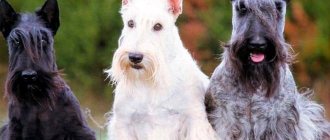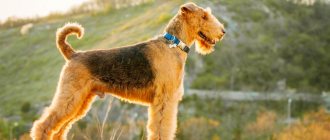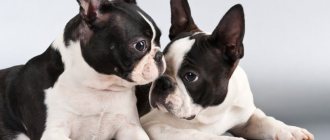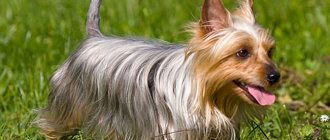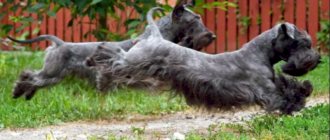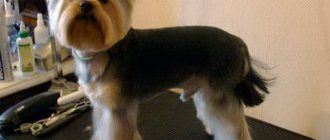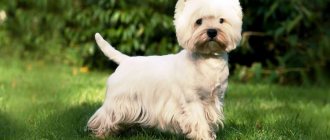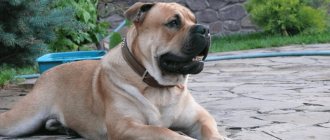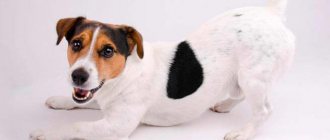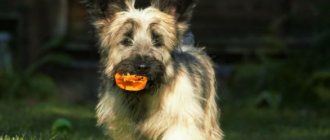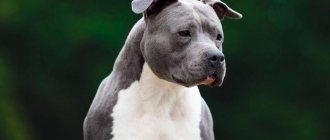Modern young people have no longer seen the era of Karandash, the legendary Soviet clown. However, in the middle of the last century, the artist was very popular. The appearance of this man with his famous dog Blob in the circus arena caused great delight among all spectators.
Reference! Mikhail Nikolaevich Rumyantsev (1901-1983) - People's Artist of the Soviet Union, Hero of Socialist Labor. He performed under the creative nickname Pencil. He devoted his entire life to a circus career and left a good, cheerful memory of himself. The artist made a huge contribution to the development of clownery, creating a new approach to circus art. His compatriots even called him the Russian Charlie Chaplin.
Pencil Dog
History of the Scottish Terrier breed
Scottish Terrier
Despite the fact that Scotties are considered the oldest dog breed in Scotland, they managed to stand out from the large clan of terriers only in the middle of the 19th century. It was during this period that the paths of the short-legged Scottish and long-haired English terriers diverged, and they finally stopped crossing with each other. However, the matter never came to a real classification, so for several decades, Scottish terriers were called any dogs that specialized in catching barn rats and burrow hunting. And, as you know, West Highlands, Skye, and even Cairn terriers did this quite successfully. The process of formation of the breed was slowed down by spontaneous breeding. According to contemporaries, every Scottish village of the 19th century had its own ideal type of terrier, often the carrier of an unimaginable mixture of genes inherited from a dozen other breeds.
Scotch terriers began to form a separate family in 1879, after the decision of the English Kennel Club to distinguish Scottish terriers into classes based on their colors. History has even preserved the name of one of the first breeders, who played a vital role in separating Scotch Terriers from their fellow breeders. He turned out to be a certain Captain McKee, who in 1880 traveled around the Scottish provinces and bought animals with wheat and black shades of wool from peasants. It was thanks to his efforts that in 1883 the Scottish Terriers finally received their own breed standard, completely separating themselves from the snow-white West Highlands and the mazury natives of the Isle of Skye.
Scottish terriers came to the United States in the 80s of the 19th century, but at first they didn’t really catch anyone’s attention. Only after Franklin Roosevelt himself acquired a representative of this breed did the Scottie receive universal recognition and love. Scotch terriers were brought to Tsarist Russia at the beginning of the 20th century, so the first owners of these shaggy “gentlemen” were members of the grand ducal family. However, the country was soon swept by the whirlwind of revolution, and the animals were quickly forgotten. The second attempt to win the hearts of Soviet dog lovers was made by the breed in the 30s, but again it did not reach the point of large-scale breeding, since the sudden outbreak of the Great Patriotic War did not contribute to such experiments. So, the USSR began to fully “stamp” Scottish terriers only in the mid-70s, when several foreign breeding bitches and males arrived at the Krasnaya Zvezda kennel.
Famous Scottish Terrier owners:
- George W. Bush;
- Mikhail Rumyantsev (clown Pencil);
- Victor Tsoi;
- Leonid Yarmolnik;
- Vladimir Mayakovsky;
- Leonid Utesov.
How did the Blob appear?
At the beginning of his career, the clown performed alone, but wanted to make a shaggy friend for himself long before his appearance. Rumyantsev dreamed of complementing his stage appearance with a pet that would be as harmonious as possible with his own image. It’s not for nothing that they say that dogs usually look like their owners. Moreover, Karandash was initially sure that it must be a black mongrel.
The selection lasted a very long time: the dogs were either too small, or, on the contrary, huge. It is worth noting that the artist’s height was only 142 centimeters, so finding an animal of a suitable size was indeed not the easiest task.
Blob and Pencil matched the stage image as best as possible
Such a dog was found absolutely by accident - one of the neighbors in a communal apartment brought it in the late 30s. The black terrier named Nix immediately suited Karandash, as if they had worked together in the arena all their lives, and became a bright completion of his stage image.
Seeing this dog, Rumyantsev immediately decided to include him in his circus acts. Under the guidance of the artist, who at that time was not yet famous and honored, the pet began to earn its own food.
The nickname “Blob” was suggested by Rumyantsev’s wife. One day she saw the dog sitting on a bright red circus carpet and noted that it looked like a large inkblot. Pencil approved his partner's new stage name, and since then the dog has always entered the arena under the name Blob.
Appearance of the Scottish Terrier
Scotch Terrier puppy
The Scottish Terrier is a squat, shaggy “Scot” with a stylish, slightly unkempt beard and short legs that masterfully cope with digging out even the hardest ground. Belonging to the group of small terriers, Scotties cannot boast of an impressive build, but they cannot be called real midgets either. The average height of an adult dog is 25-28 cm, weight is up to 10.5 kg, and these parameters are the same for both males and females.
Head
The Scotch Terrier's skull is elongated, almost flat, with a distinct stop that matches the eyes.
Teeth and bite
All representatives of this breed have very large teeth, and the jaws are closed in a full, scissor bite (the upper incisors completely cover the lower dentition).
Nose
The Scottish Terrier's nose is massive and rich black in color. The line running from the lobe to the dog's chin has a slight slope.
Eyes
The Scotch Terrier's wide-set, dark brown eyes are almond-shaped and slightly covered by overhanging eyebrows. The dog's gaze is inquisitive, perceptive, perky.
Ears
Scottish terriers have elegant and very thin erect, pointed ears.
Scottish Terrier in a cute sweater
The Count and his estate
Neck
The dog's neck is not overly elongated and moderately muscular.
Frame
Scotch Terrier muzzle
The Scotch Terrier's back is short, with a flat, almost horizontal top line. The chest of representatives of this breed is wide, noticeably protruding forward and slightly lowered towards the bottom.
Legs
The forelimbs are short, with straight, bony forearms and level pasterns. The hind legs are more massive, with large hips and short but strong hocks. The dog's paws are arched, balled, with large pads. Despite its pronounced short legs, the Scotch Terrier copes with loads quite successfully: a forced march of 10 km and an hour and a half of digging a pit for a Scottie is far from the most difficult work.
Tail
Wheaten Scotch Terrier
The Scotch Terrier has a small (16-18 cm) tail, thickened at the base, which is carried almost vertically. A slight tilt is also acceptable.
Wool
The Scottish Terrier's coat is formed by a short, close-fitting undercoat combined with a wiry outer coat. The fur reaches its greatest length and thickness in the lower part of the dog’s body, forming the so-called “skirt” and “pants”.
Color
The correct Scotch Terrier can be black, wheaten in all its variations or brindle colors. Moreover, in the case of brindles, all types of shades are considered acceptable.
Disqualifying faults
Everything here is the same as with representatives of other breeds: the exhibition commission can exclude an animal from the list of competitors for pronounced physical defects or for behavioral deviations. In particular, overly cowardly and overly aggressive Scotch Terriers are definitely not going to get into the ring.
Clown and his faithful dog
Clown Pencil “in the world” had a completely different name, his name was Mikhail Nikolaevich Rumyantsev (1901-1983). People's Artist of the USSR, Hero of Socialist Labor, and simply a beloved person, rarely appeared in public without his funny dog.
Nikolai Rumyantsev began working in the circus in 1935; the dog did not appear in his performances right away. One of his neighbors in a communal apartment gave him a Scotch terrier, which the clown decided to include in his circus acts. So, the dog began to earn its own food, under the guidance of a then not yet famous and undeserved artist.
Photo of Scotch Terrier
Death
Despite his advanced age, Karandash was distinguished by good health, which allowed him to remain in the profession and go to the arena until his last days. True, in the 1960s, the clown had to abandon acts associated with the risk of life, and exclude tricks on a rope and under the circus big top from the program.
Looking at the made-up artist, the audience thought that Karandash would delight them with funny satirical reprises for a long time. Unfortunately, Rumyantsev did not last forever, and on March 31, 1983, the creative world was shocked by the news of his sudden death. The cause of death of the popularly beloved clown was pneumonia, which developed against the background of hypothermia and a common cold.
View this post on Instagram
A post shared by Lana Kostuk (@lanakostuk) on Mar 11, 2022 at 9:32am PDT
Monument to Pencil and the dog Klyaksa
Until now, fans bring flowers to the grave of Mikhail Nikolaevich, located in the 10th section of the Kuntsevo cemetery, and then return home and review footage of their favorite performances.
Colleagues also paid tribute to the memory of Karandash and his faithful companion, the dog Klyaksa, by erecting monuments on Efremova Street in Moscow and in front of the state circus building in Gomel.
Character of the Scotch Terrier
The Scottish Terrier is a dog with character and a pronounced Napoleon complex, so don’t expect to raise him into a sentimental lazy person and a couch sissy. Non-stop hugging, lazy lying on the owner's lap - this is not about Scotch terriers. Proud and independent, they will not allow themselves to be turned into a living toy, no matter what privileges and delicacies loom before them.
Santa and his elf
However, it’s also not worth putting Scotties in the category of insensitive crackers, because for all their obstinacy they experience an almost pathological attachment to their owner. Moreover, these bearded “energizers” are not at all averse to fooling around, lying on the bed together or taking on the function of a shaggy hot water bottle, but for this they need to wait for the appropriate mood. Scotch terriers cannot and will not love under force or command.
Scottish terriers are extremely curious, so they really need fresh impressions, which they try to stock up on for future use during walks. So, just accept that when you go outside, Scotty will search all the holes and potholes for living creatures. If none are found, the dog will definitely try to compensate for the failure by destroying flower beds and lawns. But at home, the Scotch Terrier is a model of equanimity and good manners and can spend hours looking out the window, watching the drizzling rain and thinking about something of its own.
Let's be friends!
Representatives of this breed are extremely intelligent and do not suffer from excessive importunity: if the owner is sitting at work or watching an action-packed film, the Scottie will not flicker before his eyes in an attempt to divert his attention. As a last resort, he will simply sit next to you, hinting that he is ready to share his leisure time. And for Scottish terriers, an emotional connection with the owner is very important, so often involve the dog in spending time together, whether it’s cooking barbecue in nature or simply washing the floors.
The more an animal comes into contact with humans, the faster it develops, and vice versa - the less attention is paid to the Scotch Terrier, the more it withdraws into itself and becomes stupid. If a “Scottish” whiles away his days alone, in an enclosure, because you are too busy with work or organizing your personal life, don’t even hope that he will grow up to be a friendly intellectual. The most you can hope for is a hot-tempered brawler who hates tactile contact in all its forms. By the way, about fights: getting involved in them is as natural for Scotch Terriers as, for example, digging a hole. Moreover, the Scottie absolutely does not care about the size of the enemy - he will attack the Alabai with the same fury as the Chihuahua.
Pros and cons of the breed
A review of the breed and owner reviews allows you to highlight the advantages and disadvantages of this dog.
| pros | Minuses |
| Discreet, calm | Jealousy of the owner |
| Friendly, cheerful | Regular shedding |
| Cheerful, energetic | Stubbornness |
| Smart | Display of aggression |
| strong-willed | Mood variability |
| Loyal Companion | Poor compatibility with other animals |
| Good hunter | Likes to dig holes |
| Correct proportions and attractive appearance | Low at the withers (sometimes this is an advantage) |
The Scottish Terrier is an interesting dog, reminiscent of a gentleman in character and behavior. She is smart, focused and at the same time has a sense of humor. But if real danger arises, the Scottie will stand until the end - the hunter’s instinct will come into play.
Definitely suitable for those owners who need not just a funny dog, but a personality with character.
Education and training
Extremely intelligent, but extremely stubborn, does not tolerate criticism, but is very sensitive to praise and flattery - this is all you need to know about the Scotch Terrier's learning abilities. At first, Scottie is actively involved in the training process, but as soon as the lessons begin to lose the effect of novelty, the dog moves on to other, more interesting activities. Another trait of the breed that is not the most pleasant for a dog handler is selectivity. The Scottish Terrier can perfectly follow commands that involve some exciting action (“Look!”) and willfully ignore boring options like “Sit!” You will have to get out of the situation with the help of gentle persuasion and treats; other methods have little or no effect on Scotties.
Waiting for a reward
There are no special programs for training Scotch Terriers, although breeders never tire of repeating that teaching a “Scot” using the classical method is just a waste of time. It is better to combine play and study, cutting down the lesson time as much as possible. Scottish Terriers are not the kind of dogs that work through force, overcoming boredom and fatigue. For the same reason, there is no point in taking them to the training ground: classes there last a long time, which is already unbearable for representatives of this breed.
In order not to chase a pet driven by its hunting instinct while walking, accustom it to walking on a leash before going outside, that is, from the age of three months. Consider also the fact that young Scottish Terriers are quite destructive, and there is no cure for this. Hide your expensive shoes for a while and avoid making too much repairs until your dog is older. It is not forbidden to lightly spank puppies that are too insolent and presumptuous with a newspaper/rag, but the method only works if the young troublemaker understands why he is getting a “bun”.
It is known that little “Scots” love to bite, but you should not condone such outbursts of aggression, nor should you abuse negative reinforcement during the puppy’s training. It is other dogs that perceive the owner’s cry as a stimulus. For the Scotch Terrier, such signals are a reason for unnecessary frustration and resentment. And one more thing: do not expect that in the very first lessons your child will begin to demonstrate miracles of intelligence. This is a breed that needs to first evaluate the appropriateness of the given command and only then carry it out, so do not burden the puppy with repeated repetitions of exercises and endless demands.
Interesting Facts
The Scottish Scotch Terrier attracts its fans due to its funny appearance and “British” character. Not surprisingly, many unusual facts are known about this dog:
- The Scottish terrier was kept by 2 US presidents - T. Roosevelt and D. Eisenhower.
- The terrier was the companion of the brilliant physicist A. Einstein.
- This cute dog has repeatedly attracted the attention of writers. Thus, the Scottish terrier became the hero of R. Kipling’s book “Your Faithful Dog Boots.” This adventure story about 2 dogs has been translated into several languages, including Russian.
- Of course, the Scotch Terrier also became the hero of films. Fans of old cinema will probably remember that in the Soviet TV series “The Adventures of Sherlock Holmes,” a black Scottish terrier was the favorite companion of Inspector Lestrade, played by Bronislav Brondukov. True, the screen dog, according to the script, died suddenly due to the fact that the unlucky policeman confused the medicine with poison.
- The legendary clown Pencil often performed acts with the participation of his assistant Scotch, nicknamed Blob. Few people know that in fact her role was played by 17 similar understudies.
- The Scotch Terrier also became the “face” of Scotch whiskey under the Black&White brand.
This is interesting! The dogs earned the affectionate name “Scotty” long ago, when they were best friends for hunters, and now this nickname is also in use.
Hunting with a Scottish Terrier
Today's Scotch Terriers rarely hunt, but not because of the loss of the pursuit instinct, but rather because of the reluctance of the owners to engage with the dog. Modern breeders rely on the image of their pets, therefore, not every owner is ready to allow their glamorous handsome dog to dig and get dirty in the ground. However, if the instinct of a getter is your everything, and you don’t mind slightly spoiling the external gloss of your “Scot,” visit the baiting stations, if there are any in the area. There, the Scotch Terrier will quickly be reminded of his main purpose, and in a month or two a highly qualified fox catcher and conqueror of the deepest holes will walk next to you.
It's time to hunt...
Where is this fox?
The legendary duo of the Soviet circus
Rumyantsev worked in the circus arena for a little over 55 years. The presence of his name on the poster always meant a full house. At first he acted as a tramp, invented by Charlie Chaplin, but since 1935 he created a new unique comic image, named after the famous French cartoonist Caran D'ash.
The Soviet clown rarely went out in public without his funny little dog. Their joint performances created a real sensation. All spectators, especially children, rejoiced at the performance of the legendary clown’s trained dog. They waited impatiently for intermissions to get closer to the dog, touch it, look at it and stroke it. This inseparable duet remained forever in the memory of the audience, although the artist did not immediately have a four-legged partner.
The joint performances of Blobs and Pencil created a real sensation
Maintenance and care
Caught the ball
Scottish Terriers feel great in small apartments, provided they are given good exercise. As for the placement of the puppy, kennel owners recommend placing the Scottish Terrier in the same room with the owner, because this breed needs close emotional contact with a person. And this way it will be easier for the puppy to remember who his older friend and teacher is now. It is better to select a Scottie bed with low wooden sides (up to 10 cm) and install it so that it rises a couple of centimeters above the floor. This will protect your pet from treacherous drafts. Toys should also be present in the life of a Scottish Terrier, but if necessary, they can be replaced well by an ordinary apple or a cabbage stalk.
The floor in the room where the Scotch Terrier puppy lives will have to be covered with rugs or newspapers for the first time. On slippery surfaces, the baby’s paws move apart, and as a result, the dog develops an incorrect posture. Speaking of handling: until the Scottish terrier matures, take him out for walks on a leash, and not on a harness, which deforms the baby’s already weak forelimbs. And in general, it is better to refuse this accessory if neither you nor your pet plans to “rock” in the ring in the future.
Walks
The Scottish Terrier is not a breed for adepts of passive pastime, if only because up to six months you will have to walk the puppy every two to three hours. From six months to one and a half years, Scotties are taken outside up to four times a day. After the puppy turns one and a half to two years old, you can switch to regular walking twice a day, with the duration of each excursion being at least two hours. If you don’t want to hang out in parks and squares for so long, take your four-legged friend to the boardwalk three times a day, reducing the time of one walk to 60 minutes.
Scottish Terriers love long walks
Hygiene
There is no seasonal shedding in Scottish Terriers. Twice a year, the animals' undercoat is renewed, but the guard hair remains in its proper place and dies off gradually. In this regard, Scotch Terriers are not cut, but trimmed, removing tufts of loose hair. Typically, plucking is done twice a year in a grooming salon, where a specialist not only removes dead undercoat from the dog, but also gives its silhouette the necessary breed characteristics. However, some breeders recommend not limiting themselves to seasonal grooming, but periodically plucking the Scottish Terrier yourself (once a month), removing dead hair all over the body.
Important: the Scotch Terrier’s first acquaintance with the procedure of plucking hair should take place no earlier than the animal is six months old.
Bath procedures
The most common mistake when grooming a Scottish Terrier at home is leaving too much undercoat on its “pants” and “skirt.” Scotty is not a lapdog, and he has no use for flying hair on his thighs. Scottish Terriers need to be bathed once a month, washing the coarse hair with a nourishing pet shampoo and moisturizing it with conditioner or leave-in cream to make combing easier. But this is all in theory. In practice, you have to wash the restless “Scots” almost five times a day. Not only does the Scotch Terrier’s “skirt” collect liquid dirt during walks, but the pet itself strives to dig into the ground and generously sprinkle it on its own “fur coat.” Partially solving the problem of soiled fur is purchasing protective overalls, but only partially, so get used to the fact that this breed cannot be treated without daily water procedures.
A little about brushing Scottish Terriers. You can only tidy up clean fur: never try to comb a dirty dog that has suddenly discovered tangles. First, wash the animal thoroughly, and you may not have to fight with matted fur at all. Scotch terriers are combed in two steps: first with a brush, then with a wide-tooth comb. Pieces of wool that cannot be untangled can be carefully removed with a tangle cutter. If the structure of your ward’s decorative hair leaves much to be desired, try rubbing an oil mixture with the addition of rosemary esters into the coat; it has not only a stimulating, but also a slight dirt-repellent effect, which is extremely important for Scotch terriers.
Be sure to keep your dog's beard clean. Wipe your pet's face after each feeding, or even better, buy him a special flat food bowl and a water bottle. Scottie's ears are healthy, so caring for them is not burdensome - just a simple weekly cleaning of the ear is enough. The dog's claws and eyes will require a little more attention. The first ones grow very quickly, so they need systematic cutting. The latter may react with inflammation to external irritants; therefore, periodically it may be necessary to wash the mucous membrane with chamomile or tea infusion.
Feeding
Where's the food?
The main source of protein for an adult Scottish Terrier is lean, raw beef. Lamb, like pork, is a time bomb for the liver and guaranteed diarrhea, so we immediately discard them. Boiled offal can be a good alternative to beef, but not more than a couple of times a week. By the way, Scottish terriers usually do not suffer from allergies, so turkey and skinned chicken are not prohibited for them.
Three to four times a month, the Scotch Terrier is pampered with boiled sea fish without bones. In addition, the dog’s menu should always include low-fat fermented milk products. Buckwheat and oatmeal are useful cereals for Scotties, and carrots and cucumbers are useful for vegetables. Rice is also considered a nutritious grain, but the “Scots” have problems with stool from it. Natural dietary supplements like bone meal (just bones are prohibited) or vegetable oil will be a good support for the body, although mineral supplements from a pet store are also not the worst option.
If you plan to feed your Scottish Terrier dry food, give preference to the super-premium and holistic class. With this type of nutrition, taking additional vitamin and mineral complexes is not required.
And of course, you need to carefully monitor the dog’s condition. If your pet has lost a little weight but is quite healthy, put more food in his bowl. The lazy people occupying the sofa, on the contrary, should cut their rations.
Personal life
In Soviet times, it was not customary among artists to advertise their personal lives, so little is known about Karandash’s wife and children. Married to circus assistant Tamara Semyonovna, whose maiden name is not mentioned anywhere, Mikhail Nikolaevich lived for more than 50 years, and during this time the couple became the parents of an intelligent and talented daughter Natalya and grandparents of their granddaughter Ovene.
Mikhail Rumyantsev (still from the film “Assemble Venus”)
Being colleagues and like-minded people, Mikhail and Tamara survived the war together, and then recalled with laughter the episode when the clown was not allowed on the train with a dog, and he had to travel for 3 months to Omsk by passing transport and on foot.
The only problem in the relationship was Pencil's love for strong, high-quality alcohol. In his dressing room there was a special hiding place where he hid vodka or a bottle of expensive, scarce cognac from his wife. Despite this, the artist approached his work very responsibly and never drank before going to the arena.
Another feature of Mikhail Nikolaevich’s nature, who seemed cheerful and carefree from the outside, was his exactingness towards others and incredible punctuality. Having become a famous and respected artist, Karandash strictly reprimanded his colleagues for being late to rehearsals and became very nervous when anyone began to argue with him.
Published by Vyacheslav Kirillov Wednesday, April 26, 2017
Pencil without makeup
Colleagues recalled that, having become popular, Pencil retained his natural modesty and was careful to ensure that his name or photograph under no circumstances appeared on circus posters. And once, when he was placed in a luxury room, and the rest of the artists were in a dormitory, the clown scolded the organizers and then refused to go to the arena.
Relatives and friends of Mikhail Nikolaevich repeatedly spoke about these and other cases. In addition, stories from the life of the great clown were reflected in documentary filmography and included in the biographical book of art critic Natalya Rumyantseva “Pencil”.
How to choose a puppy
I like this place
- Eight-week-old Scottish Terriers are extremely difficult to check for compliance with the standard, since puppies begin to acquire breed characteristics only in the fifth or sixth month of life. That is why it is important to contact an honest, trusted nursery, where all offspring are obtained from planned matings and are necessarily registered.
- If you are afraid of making a mistake in your choice, look for a breeder who sells six-month-old teenagers. At this age, it is much easier to determine the prospects of a Scottish terrier, but such a puppy will also cost many times more than his two-month-old brothers and sisters.
- In Scotch Terrier puppies, the head is disproportionately developed and looks too massive. This is fine. If a two-month-old baby looks fully formed and looks like an adult animal, this is far from an advantage. Growing up, such individuals, as a rule, have lightweight bones and a short skull.
- Check how healthy the puppy you like is. Look into his ears and the area under his tail: both there and there should be clean. There should be no redness in the groin cavity and under the armpits.
- Assess the type of temperament of the kids and their habits in the group. Too shy and slow Scotties are an unenviable acquisition.
- Avoid buying a puppy that is too shaggy and has a well-furred skull, since with age it will most likely turn into a soft-haired fluffy dog, which is a serious defect for Scotch Terriers. It’s better to take a closer look at babies with smooth fur, without traces of grooming hair.
Additional Information
As has been mentioned many times in the article, the Scottish Terrier is a very proud and willful dog. He is distrustful of strangers and will most likely choose only one owner for himself. It should be noted that the Scottie is also a very jealous dog, so it is difficult for him to share his person with other pets, and his hunting instincts make it impossible to be close to rodents, birds and other small animals.
If the family already has a cat or other pet, it is worth introducing the animals gradually and constantly monitoring the dog’s behavior. Without proper education and attention, an unpleasant situation can occur. It is not recommended to let your Scottish Terrier go without a leash. Due to its strong hunting instinct, the dog may strangle the neighbor's cat or other small animals. Training must be taken very seriously and started from a very early age, because later it will be impossible to re-educate an adult dog.
Photos of Scottish Terrier puppies
Filmography
- 1938 – “New Moscow”
- 1939 – “Girl with character”
- 1939 – “High Award”
- 1941 – “The Furious Fisherman”
- 1942 – “Concert to the Front”
- 1944 – “Ivan Nikulin – Russian sailor”
- 1948 – “Pencil on Ice”
- 1955 – “The Self-Confident Pencil”
- 1964 – “Collect Venus”
- 1966 – “This is very, very serious...”
- 1967 – “Circus Day at VDNKh”
- 1969 – “Two Smiles” (Story “Freaks”)
- 1983 – “Circus of our childhood”
- 1969 – “Parade Alley”
Scotch Terrier price
The cost of Scottish Terrier puppies is determined not only by their belonging to a certain class (pet, show, breed), but also by the color of the animals. For example, there are always more advertisements for the sale of Scotties with black wool, and accordingly, their prices are lower: about 30,000 - 35,000 rubles. Wheaten Scotch Terriers are a less common phenomenon due to difficulties in breeding, but they are more expensive - from 40,000 rubles per puppy. The most expensive option is show-class Scottish terriers with breeding rights. The price for these representatives of the canine elite ranges from 80,000 - 100,000 rubles.
How many dogs did Pencil have?
The dog's life is not so long, so Pencil performed with many Blots. When the dog left for another world, the clown picked up a new pet, which was indistinguishable from the previous one. The audience didn’t even realize that this was not the same Blob.
During his creative career, Rumyantsev replaced 13 different Blots
All the followers of the first dog bore the same sonorous and unusual nickname, even if they were written differently in the veterinary passport. In total, during his creative career, Rumyantsev replaced 13 different Blots.
Possible diseases
The Scottish Terrier breed , as a rule, has good immunity. It is purchased with mother's milk. But throughout life it is influenced by factors such as a balanced diet, timely vaccination, and proper care. Vitamin supplements are optimal for prevention. They should be used if the dog eats natural food. Walking is also beneficial.
Mom scotch terrier with puppy
The future owner should keep in mind that the dog is susceptible to skin diseases. These include atopic dermatitis and allergies. Mast cell cancer and melanoma, a malignant tumor of the skin, are possible. Lymphosarcoma often occurs.
Among the endocrine diseases, hypothyroidism is a popular disease – insufficient function of the thyroid gland. The disease manifests itself in a change in the dog’s appearance - the skin becomes dull, constant shedding begins, hair loss begins, the dog becomes apathetic and lethargic, and its character changes.
Among the ophthalmic ailments, the Scotch Terrier is most often affected by cataracts. In addition, the dog may suffer from bladder cancer and von Willebrand disease. Viral diseases – plague, hepatitis, rabies – cannot be excluded. These are dangerous illnesses that can end in disaster. As a preventive measure, vaccinations and hygiene rules are required.
Any of the listed diseases requires consultation with a specialist. It would also be a good idea to register with a specific veterinarian and take your pet for preventive examinations from time to time.
